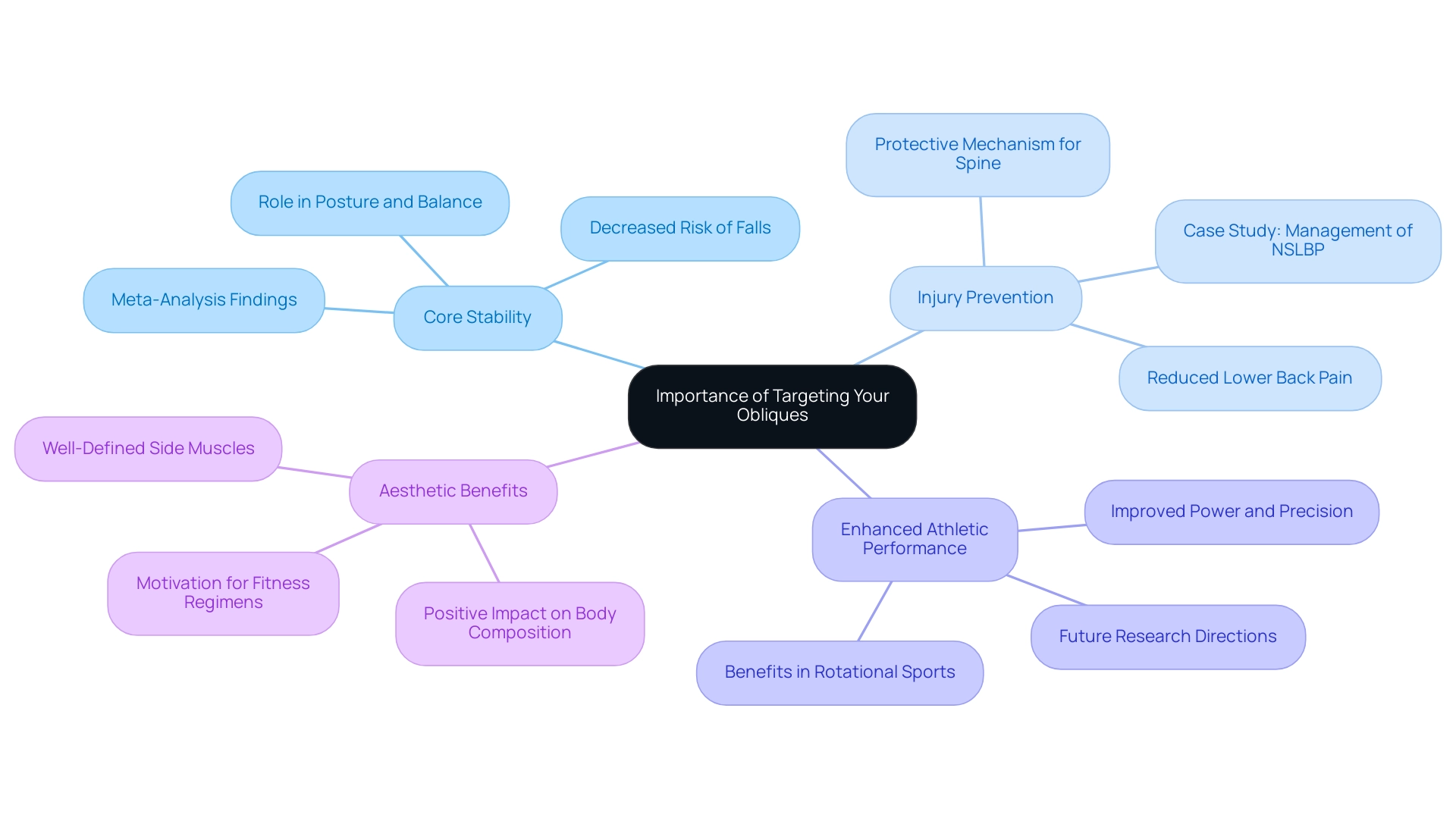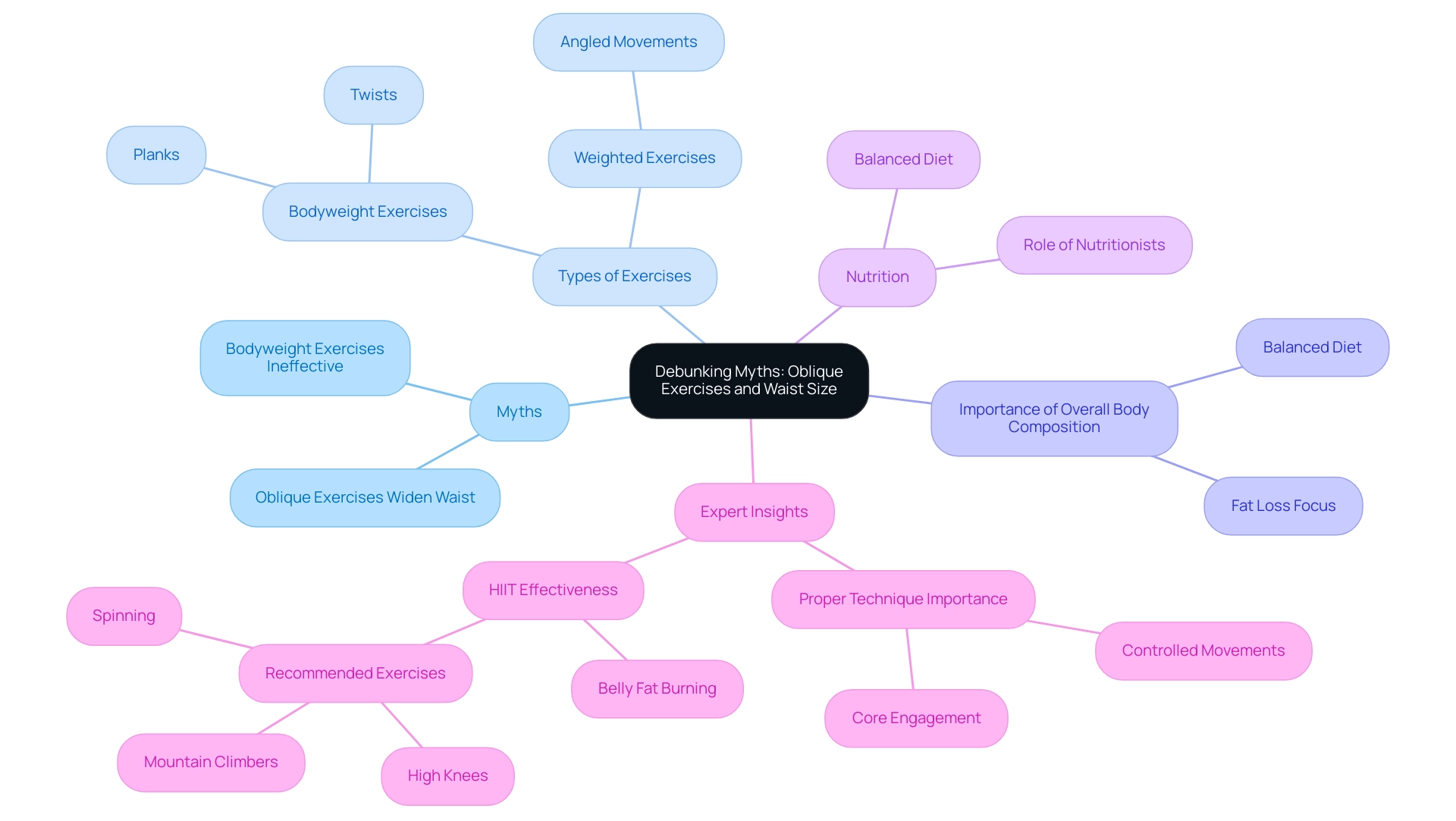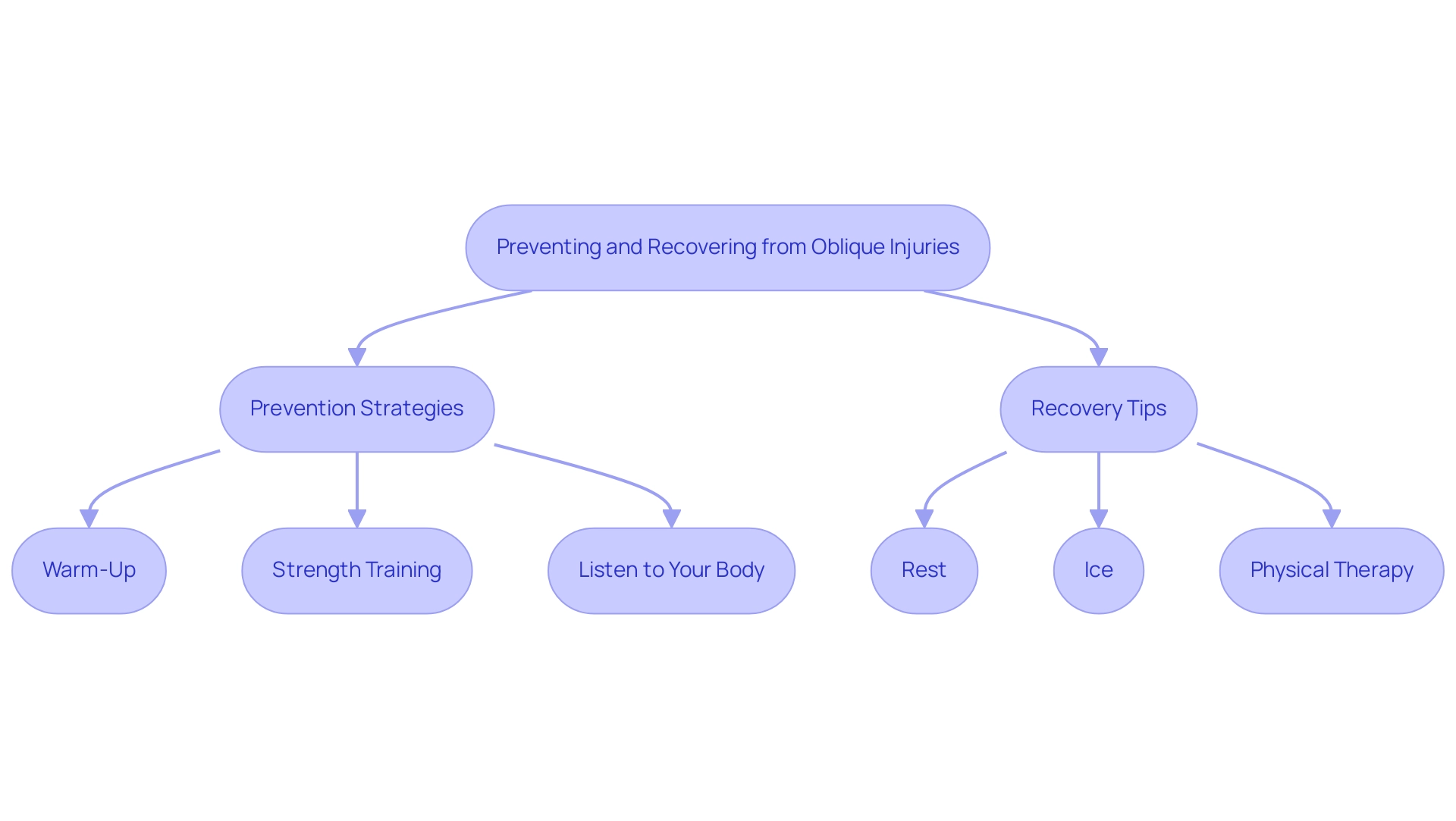Overview
The article examines the development of underdeveloped obliques, underscoring their essential function in core stability, athletic performance, and injury prevention. It elaborates on the key roles of the oblique muscles, outlines targeted exercises designed for their enhancement, and stresses the significance of personalized training regimens to bolster overall core strength and mitigate injury risks.
Introduction
The oblique muscles, frequently overlooked in fitness discussions, are crucial for core strength and stability. Located on the sides of the abdomen, these muscles are vital for a diverse array of movements, encompassing both athletic performance and everyday activities. Grasping their anatomy, functions, and the significance of targeted training can reveal substantial benefits for overall health and fitness.
As research continues to uncover the intricacies of these muscles, it becomes evident that they are not merely ancillary players in the core; rather, they are central to effective training strategies.
This article explores the anatomy of oblique muscles, their essential functions, and the most effective exercises to strengthen them, while also clarifying common misconceptions and injury prevention tactics that can enhance both athletic performance and overall well-being.
Understanding the Anatomy of Oblique Muscles
The underdeveloped obliques, the slanted muscles located on the sides of the abdomen, play a pivotal role in core stability and strength. These muscles are classified into two main categories: the external muscles and the internal muscles. The external muscles, the largest and most superficial, extend from the lower ribs to the pelvis.
Their primary functions include trunk rotation and lateral flexion, movements that are essential for various athletic activities and daily tasks. Beneath them, the internal muscles support similar functions, significantly contributing to body stability.
Key Functions of Oblique Muscles:
- Rotation: These muscles facilitate torso twisting, a movement integral to sports and physical activities.
- Lateral Flexion: They enable side bending, essential for tasks such as reaching or bending sideways.
- Stabilization: The lateral muscles assist the spine during dynamic movements, significantly lowering the risk of injury.
Recent research emphasizes the significance of underdeveloped obliques in maintaining torso stability. Studies indicate that individuals with well-developed lateral muscles exhibit superior overall core strength and stability compared to those with underdeveloped obliques, a factor critical for athletic performance and injury prevention. Furthermore, understanding the anatomy of these side muscles can inform targeted training strategies that enhance their function.
Statistics reveal that approximately 46% of individuals in certain demographics may have variations in diagonal muscle anatomy, which can influence training approaches. This highlights the necessity for personalized fitness regimens that account for individual anatomical differences. Notably, the interfoveolar muscle has been observed in 46% of Chinese individuals, underscoring the diversity in muscle anatomy that trainers should consider.
Incorporating workouts that specifically target underdeveloped obliques can lead to improved performance across various physical activities. By focusing on both the external and internal muscles, individuals can cultivate a more robust core, thereby enhancing their overall physical capabilities and minimizing injury risks. As Lauren Adams from the Department of Exercise Sciences at Brigham Young University asserts, understanding these muscles is crucial for effective training.
Additionally, the case study titled "Comparative Kinesiology of the Human Body" emphasizes the importance of muscle coordination and its implications for training strategies related to side muscles. This insight reinforces the need for targeted exercises to enhance spinal stability and overall musculoskeletal health.
As our understanding of the functions of slanting muscles continues to evolve, it becomes increasingly clear that these muscles are not merely supplementary but essential to effective trunk training and overall athletic performance. By investing in programs that enhance stability, organizations can foster a culture of health and unity, aligning with Foresight Health Coaching's mission to build stronger and more resilient teams.

The Importance of Targeting Your Obliques
Targeting your obliques is essential for several compelling reasons:
- Core Stability: Strong obliques play a pivotal role in achieving a stable core, vital for maintaining proper posture and balance. Studies suggest that a well-developed center can greatly improve overall stability, decreasing the chances of falls and harm in both athletic and daily activities. A meta-analysis emphasizes the significance of including foundational training in sports where balance is essential, as it can lower the likelihood of lower limb injuries.
- Injury Prevention: A robust core that incorporates well-developed obliques acts as a protective mechanism for the spine, effectively reducing the risk of harm during physical exertion. Research has demonstrated that individuals with strong central muscles experience fewer occurrences of lower back pain and related injuries, underscoring the importance of central training in injury prevention strategies. The case study titled 'Management of Non-Specific Low Back Pain (NSLBP)' illustrates that abdominal strengthening exercises (CSE) have shown promise in treating NSLBP by improving spinal control and promoting patient independence.
- Enhanced Athletic Performance: Many sports, particularly those involving rotational movements such as golf, tennis, and baseball, benefit from strong side muscles. Enhanced core stability translates to improved performance, especially for athletes with underdeveloped obliques, as they can execute movements with greater power and precision. This is particularly relevant in sports where balance is crucial, as strong side muscles can help mitigate the risk of lower extremity injuries associated with underdeveloped obliques. As noted by Daniel Jerez-Mayorga, a postdoctoral researcher, future research should focus on the long-term efficacy of CSE and its effects in isolation from other modalities.
- Aesthetic Benefits: Beyond functional advantages, addressing underdeveloped obliques leads to well-defined side muscles, contributing to a toned appearance and positively impacting overall body composition. This aesthetic factor can motivate individuals to incorporate angled workouts into their fitness regimens, further enhancing their commitment to health and wellness.
Incorporating targeted angled exercises into your routine not only leads to improved functional strength but also fosters better overall fitness. By concentrating on central stability through angled training, individuals can enhance their athletic performance while also decreasing the likelihood of injuries, making it an essential element of any comprehensive fitness program. The longest follow-up in the studies was three months, indicating the duration of observed benefits from core training.

Top Exercises for Developing Strong Obliques
To effectively develop strong obliques and enhance workplace wellness, consider incorporating the following exercises into your fitness routine:
- Side Plank: This exercise is essential for activating the side abdominal muscles. Aim to hold the side plank position for 30 seconds on each side, focusing on maintaining a straight line from head to heels.
- Russian Twist: Begin seated on the floor with your knees bent. Lean back slightly and twist your torso side to side while holding a weight, ensuring that your abdomen remains engaged throughout the movement.
- Bicycle Crunch: Lie on your back and lift your legs into a tabletop position. Alternate bringing your elbow to the opposite knee in a cycling motion, which effectively targets the side muscles while also engaging the entire core.
- Woodchopper: Utilize a cable machine or a medicine ball to perform a chopping motion. This dynamic activity involves the lateral muscles throughout the movement, enhancing rotational strength and stability.
- Oblique Crunch: Lie on your side and perform a crunch by bringing your elbow towards your hip. This focused movement targets the side muscles, specifically addressing underdeveloped obliques to promote strength and definition.
- Twisting Leg Raises: This movement is crucial for oblique workouts and provides superior oblique activation. Lie on your back, lift your legs, and twist them side to side while keeping your core engaged.
For optimal results, aim to include these activities in your routine 2-3 times a week. Research indicates that regular participation in core-strengthening activities can significantly enhance overall fitness, with studies showing that individuals who perform targeted workouts experience improved performance and reduced fatigue. Notably, just two studies have examined the transversus abdominis muscle, underscoring the necessity for additional high-quality research in this field. J.M.M. remarked, "the level of evidence of the included studies was mainly moderate, which suggests that more high-quality research is necessary to reduce the risk of bias and draw solid conclusions about muscle activity."
Furthermore, a comprehensive fitness routine that incorporates side workouts can result in heightened motivation and involvement in the workplace, promoting a healthier and more productive atmosphere. By investing in these activities, you not only strengthen your core but also contribute to a culture of health and unity within your team.
Explore how Foresight Health Coaching's corporate partnership can provide tailored wellness programs that enhance employee performance, creativity, and stress management, ultimately benefiting your organization’s success.
Debunking Myths: Do Oblique Exercises Widen Your Waist?
A common misconception is that oblique exercises can lead to a wider waist. This belief is largely unfounded. While heavily weighted angled movements may increase muscle size, bodyweight routines such as planks and twists typically do not contribute to a broader waistline. Instead, these activities are effective for toning and defining the waist. To achieve a slimmer appearance, focusing on overall body composition and fat loss is crucial.
Including a balanced diet and regular cardiovascular activity alongside lateral training is essential for optimal results. Research indicates that high-intensity interval training (HIIT) can be particularly effective in burning belly fat, making it a valuable addition to any fitness routine. A January 2017 study published in the Journal of Diabetes Research supports this, highlighting HIIT's role in weight management and overall physical health.
Furthermore, expert insights underscore the significance of proper technique in angled training. As Wilson states, "Ab routines that are performed incorrectly are not advantageous for the midsection and can be potentially harmful for the spine." Controlled movements and effective core engagement are vital to avoid unnecessary muscle growth in underdeveloped obliques.
Nutritionists also emphasize that a comprehensive approach to body composition, rather than isolated activities, is essential to achieving desired fitness results. Additionally, incorporating cardio and full-body strength training is recommended to complement spot reduction efforts. The case study titled "Benefits of High-Intensity Interval Training (HIIT)" emphasizes how HIIT is an effective approach for burning belly fat, with various activities such as high knees, spinning, and mountain climbers suggested for their efficiency. This approach not only contributes to better physical health but also supports weight management, which is beneficial for overall employee well-being.
In summary, while myths about angled exercises and waist size persist, evidence suggests that with the right approach—focusing on form, incorporating varied training methods, and maintaining a healthy lifestyle—individuals can effectively tone their midsection without the fear of widening their waist. This holistic view aligns with Foresight Health Coaching's mission to promote health and well-being in the workplace, fostering a cohesive team culture.

Preventing and Recovering from Oblique Injuries
Preventing angular harm necessitates a comprehensive strategy that emphasizes readiness and power. Consider these key strategies:
- Warm-Up: Engaging in a thorough warm-up is crucial before any physical activity. This practice conditions the lateral muscles and improves thoracic range of motion, essential for optimal performance and injury prevention. Studies indicate that an appropriate warm-up can significantly reduce the likelihood of harm, particularly in high-impact sports. Enhancing thoracic flexibility during warm-ups is vital for avoiding side muscle strains.
- Strength Training: Incorporating specific exercises that strengthen the core and side muscles is essential for developing resilience against injury, particularly in addressing underdeveloped obliques. A decade-long study on abdominal musculature injuries in professional baseball revealed an increasing prevalence of side strains, underscoring the necessity for effective strength training regimens. By focusing on these areas, athletes can better endure the physical demands of their sport.
- Listen to Your Body: Heeding any signs of discomfort or pain during workouts is imperative. Modifying your routine based on these signals can prevent minor issues from escalating into significant injuries.
Recovery Tips:
- Rest: If you experience an oblique strain, allow ample time for recovery. Overexertion can lead to prolonged setbacks, as evidenced by studies showing that players receiving cortisone or PRP injections face an average recovery delay of 11 days. Ultimately, 8.15% of players will experience at least one recurrence of a physical setback, averaging 428 days after a full return to play.
- Ice: Applying ice can help reduce inflammation and alleviate pain, facilitating a quicker recovery process.
- Physical Therapy: Consulting a physical therapist can provide tailored rehabilitation exercises that promote healing and strengthen the affected area.
By adhering to these guidelines, individuals can maintain a robust core while minimizing the risk of injuries related to underdeveloped obliques, ultimately enhancing their performance and longevity in their respective sports.

Conclusion
Oblique muscles are essential to both athletic performance and daily activities, serving a pivotal role in core strength and stability. Grasping their anatomy and functions underscores their significance in enhancing overall fitness and mitigating injury risks. By integrating targeted exercises such as:
- Side planks
- Russian twists
- Bicycle crunches
into a regular workout routine, individuals can cultivate stronger obliques that bolster better posture, balance, and athletic capabilities.
Addressing prevalent misconceptions, it is crucial to acknowledge that well-executed oblique exercises do not result in a wider waist. Instead, they contribute to a toned midsection when paired with a balanced diet and comprehensive fitness regimen. This holistic approach to training highlights the importance of core stability as a foundation for injury prevention and enhanced performance across diverse physical activities.
Moreover, prioritizing the prevention and recovery from oblique injuries through proper warm-ups, strength training, and mindful body awareness is vital. By adhering to these guidelines, individuals can foster a resilient core that not only amplifies athletic prowess but also promotes long-term health and well-being. Investing in oblique training represents a strategic step towards achieving comprehensive fitness goals and nurturing a culture of health and unity in any environment.




